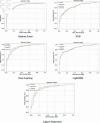Advanced predictive modeling for enhanced mortality prediction in ICU stroke patients using clinical data
- PMID: 40435317
- PMCID: PMC12118975
- DOI: 10.1371/journal.pone.0323441
Advanced predictive modeling for enhanced mortality prediction in ICU stroke patients using clinical data
Abstract
Background Stroke is second-leading cause of disability and death among adults. Approximately 17 million people suffer from a stroke annually, with about 85% being ischemic strokes. Predicting mortality of ischemic stroke patients in intensive care unit (ICU) is crucial for optimizing treatment strategies, allocating resources, and improving survival rates. Methods We acquired data on ICU ischemic stroke patients from MIMIC-IV database, including diagnoses, vital signs, laboratory tests, medications, procedures, treatments, and clinical notes. Stroke patients were randomly divided into training (70%, n=2441), test (15%, n=523), and validation (15%, n=523) sets. To address data imbalances, we applied Synthetic Minority Over-sampling Technique (SMOTE). We selected 30 features for model development, significantly reducing feature number from 1095 used in the best study. We developed a deep learning model to assess mortality risk and implemented several baseline machine learning models for comparison. Results XGB-DL model, combining XGBoost for feature selection and deep learning, effectively minimized false positives. Model's AUROC improved from 0.865 (95% CI: 0.821 - 0.905) on first day to 0.903 (95% CI: 0.868 - 0.936) by fourth day using data from 3,646 ICU mortality patients in the MIMIC-IV database with 0.945 AUROC (95% CI: 0.944-0.947) during training. Although other ML models also performed well in terms of AUROC, we chose Deep Learning for its higher specificity. Conclusion Through enhanced feature selection and data cleaning, proposed model demonstrates a 13% AUROC improvement compared to existing models while reducing feature number from 1095 in previous studies to 30.
Copyright: © 2025 Abdollahi et al. This is an open access article distributed under the terms of the Creative Commons Attribution License, which permits unrestricted use, distribution, and reproduction in any medium, provided the original author and source are credited.
Conflict of interest statement
The authors have declared that no competing interests exist.
Figures







References
-
- Centers for Disease Control and Prevention Stroke; 2012.
-
- Walls RM, Hockberger RS, Gausche-Hill M, Erickson TB, Wilcox SR. Stroke. In: Rosen’s emergency medicine: Concepts and clinical practice. 10th ed. Elsevier; 2023. Available from: https://www.clinicalkey.com
-
- Phipps MS, Cronin CA. Management of acute ischemic stroke. BMJ. 2020;368. - PubMed
MeSH terms
LinkOut - more resources
Full Text Sources
Medical

